The Club history
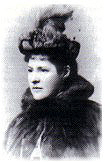
Baroness Campbell von Laurentz founded the club in 1900.
The story of the formation of the breed club is fascinating for most of us as so many things have happened in the past 121 years!
Let us begin at the beginning… Dog shows as we know them today are – on the surface at least – VERY different from those organised when the sport became “recognised” in the late 1800’s.
The introduction of the railway system made freedom to travel accessible for all classes. Thus, the already competitive sport in taverns up and down the land where the men folk could be seen sampling the local ale and comparing their favourite dogs, gradually became much more accessible.
Gamekeepers and their often titled landlords and employers were also regularly in competition. The various large estates once so much part of the landscape were proud to show off their animals.
As the new transport system began to snake its way across the countryside, this coincided with the view of a number of ladies that they too could if they wished exhibit their favourites, though in some cases it was common to send the animals unaccompanied and the show stewards attended to them throughout the show.
It is thanks to one particular gamekeeper, Richard Brailsford, and his employer Earl Howe, that in November 1859 the oldest dog show society began and was known as the Birmingham Dog Show Society - only preceded by the Newcastle Sporting Dog show in the July - though this society did not continue. Only sporting dogs were entered at this time.
By their next show, however, in December 1860,
the world was their oyster and a number of other breeds were included, some of them toy breeds – to be judged by Mr J. H. Walsh – known often by his pseudonym ‘Stonehenge’.
Class XXXIX was for Italian Greyhounds and just two were entered! Both were owned and bred by Mr Henry Gowan from London. At that time, it was usual to put a price against the dogs and these were both valued at £52 10s.
Quite a lot of money at the time!
The Illustrated News 1860 used a picture of an Italian Greyhound complete with beribboned coat when reporting the show. In 1873, the Kennel Club was formed, as the governing body of the sport and because of the formation of the Stud Book, (covering 1859-1874), early records are available.
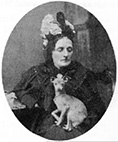
Miss Henrietta Maria Mackenzie was among those regularly found at the shows with her Italian Greyhounds. In her younger days she was an opera singer. Evidently, she was very fond of using her umbrella to indicate, in a rather definite way, her opinions! The long skirts of the ladies sweeping the saw-dusted floor of the various venues is rather different from today when trouser suits are more common.

We are very fortunate that a lady called Mrs Bessie Florence Scarlet, whose first Italian Greyhound came from Victor Hugo, wrote meticulously in her own hand about her life and that of the dogs - and owners of the period.
It was she who was to become the first Secretary of the Breed Club in 1900.
The idea had been supported earlier by such illustrious owners as Lord Abinger and his mother Lady Helen Abinger, Marchioness Beatrix of Waterford, Baroness Campbell von Laurentz, Mr H D Wood, Sir Musgrave Horton Brisco and Lady Brisco. A meeting of those interested took place in February 1900. It was soon agreed that the proposed club adopt Italy’s flag colours: red, white and green for the decoration of their dogs and cushions when exhibiting.
![]()
The modern-day exhibitor rarely decorates their show benches but up until about 20 years ago it was still usual to do this. (Consequently, The Italian Greyhound Club has used these flag colours in the logo created by Sue Dunning.)
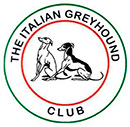
As the exhibition and ownership of Italian Greyhounds gradually became more popular, those on the show bench began to get smaller and smaller and some of their many qualities were lost. Other breeds, like the Pekingese and Pug began to usurp them in the drawing room. Some families had been proud to record that they had owned the breed for generations and did not want to see them lost. Therefore, the formation of the breed club was probably its salvation, as in April 1900 the dog press noted that the entries in classes at shows were extremely good due, it was thought, to the prospect of a club for the breed.

By June, the prospective club committee had installed Mrs Scarlett as their Secretary and had, after much consideration, drawn up a scale of points allowing for both large and small dogs – one class for seven pounds and under and another for seven to eleven pounds. Thus, sound animals of both sizes could be used for breeding and a combination of the two would preserve their soundness and type, as is still the case today, meaning the future of this delightful breed would be assured.
The application for the registration of title of "The Italian Greyhound Club" was granted, and ordered to be registered at a meeting of the Kennel Committee of the Kennel Club, held on Tuesday 3rd of July 1900.
Thus The Italian Greyhound Club was formed.
The Early Days
The formation of the Italian Greyhound Club in 1900 by the many society ladies and gentlemen owners of the period is well recorded in the dog press, as was their public discussion regarding the breed standard. In its original format, points were awarded for the various features and in April 1900 these were published as follows:
20 Head
20 Body
30 Legs and feet
15 Tail, coat and colour
15 Action and symmetry
Weight: Two classes – one of seven pounds and under,
and one over seven pounds and not exceeding eleven pounds.
The standard had been based on one drawn up in 1859 at the commencement of the dog shows and published by Idstone. The preliminary wording has always included the following phrase:
A miniature English Greyhound, more slender in all proportions, and of ideal elegance and grace in shape, symmetry and action. ( The words “English Greyhound” were later omitted.)
The points were dropped in 1909 and size section amended. Originally the colour clause stated: ‘Preferably self-coloured’ and that the colour most prized was golden fawn.
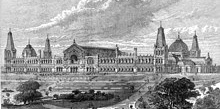
In August 1900, a show at Alexandra Palace included the classification as open dog and bitch classes, (8lbs and under and over 8 lbs), limit (mixed) any weight, novice and puppy. Plus team, brace, breeders prizes, championships and premierships. At this time the Italian Greyhound Club gave silver medals in the open classes and bronze medals in puppy and breeders classes. It was in the summer of this year that the Club also decided to adopt red, white and green as the club colours.
The supporters of the breed at the commencement of the club included Mrs B. Scarlett, (first Secretary), niece and adopted daughter of Sir Percy Shelley and his wife after the early death of her mother. Baroness Campbell von Laurentz was to become the first President and Vice Presidents were Lady Helen Abinger, Lady Brisco, Mrs Cottrell-Dormer, Miss Hodson, Mr H D Wood, Mr Berrie, Mr Ferrar, Mr Arkwright, Miss Ada Wood, Mr Matthews, Mr Austin, Mr Farmer Hall, Mr and Mrs Turner, Mrs George Raper, and the Marchioness of Waterford from Ireland became the club’s first patron.
Miss Henrietta Mackenzie was also a founder member of the Ladies Kennel Association (LKA).
Research shows that during 1900 to 1928 the subscription rate for membership of the club was 10s 6d and the cost of registration for a puppy at the Kennel Club in 1903-1919 was 2s 6d (12 p). In these early days many club members gave club specials as modern day owners do and awards like the Mackenzie Memorial for “action” and the Rosemead Cup were competed for.
In 1913, a Club show was held for the first time at the Ladies Kennel Association show and it appears to have passed off very favourably. The classes were very well filled, and the weather was good as it was a two-day show held under canvas. Bear in mind the attire of the exhibitors was not as we know it now: Crinolines and boots for the lady exhibitors were the order of the day. Travel to the shows was often by train and sometimes dogs were unaccompanied. They would be met by the stewards who would show the dogs to the judges.
Unfortunately, the onset of the first World War in 1913/1914 depleted many kennels, but thanks to Mrs Scarlett’s hand-written memoirs, we can learn of the difficulties suffered by those with dogs of the time when it was very hard to feed them, and when illnesses such as distemper, (which we take for granted are preventable these days), were prevalent. As one generation of enthusiasts disappears so others come onto the scene and, hopefully, undertake to continue the understanding of the breed that they have taken on.
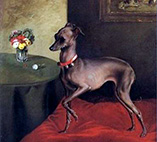
Mrs Scarlett held the post of Secretary until 1928 when Mrs C W Thring (formerly Miss E D Gilpin) of the Pinea affix took over. Mrs Scarlett had achieved admirable success in holding the club together since its formation in 1900 and throughout the first world war 1914-1918, but when she decided it was time to step down, her successor was to prove just as enthusiastic an owner of Italian Greyhounds, and also as a recorder of historical facts concerning the breed and club, allowing us to have an insight into that period.
In fact Pinea Pearlette, born 8th. July 1924 had been given as a gift from Miss Gilpin, (as she was then), to Mrs Scarlett. Mrs Scarlett died in 1934 aged 83 years of age.

Mrs Thring was responsible for the first Italian Greyhound Club News Letter and collected material for an intended book on the breed which unfortunately did not come to fruition in her lifetime. The manuscript was left to the club and though it turned out to be lots of notes and loose leaf material, Mrs Barnard of the Noways affix, Chairman of the Club at the time, produced a most useful little book from them in 1968 that is still available today after a reprint in 1981. It was Mrs Thring’s task to steer the club through the traumas of the second World War and her loyalty never flagged.
Numbers dropped of course, and provision for pets was not easy. According to the Kennel Club records, Mrs Thring judged the breed four times at Championship level, the Kennel Club Show at Crystal Palace in 1928, Southern Counties in 1955, again there in 1957 and Ladies Kennel Association in 1958.
The Champion Certificate for Mrs Thring’s Ch. Silver Atom dated 1928 still exists. Ch. Pinea Peterkins followed in the next year. The Pinea kennel consisted of many fine dogs prominent in the pedigrees of other well-known Italian Greyhounds.
Other prominent Italian Greyhound personalities joined the breed just prior to the second world war in the shape of Mrs Cynthia Howard and her mother Mrs Massey-Cooke, (Velletri and Ashgreen). These two ladies bred the first two champions in the breed after Championship status was granted again in 1955.
Insufficient registrations during the post war period had meant that this distinction was taken away by the Kennel Club. It was in this period that the well-known Di Peltrengo dogs appeared in this country from Italy. A letter appeared in the Italian Greyhound magazine in the USA March 1962 Volume III No 7 from the Club Secretary at her Sussex address to their breeder Madame Montecuccoli, advising her of the influence of these dogs at the Club show in 1961.
Mrs Thring remained Secretary of the club until 1960 when she retired after a period of ill health.
The club had had just two secretaries in the spate of 60 years!
The "Pinea bowl" was given at the Club Championship shows as a memorial.
1961 was the year that the club had its first open show held in the home of Mr and Mrs Darryl and Elizabeth Morgan of the Nagrom affix. and Mrs Molly B Garrish
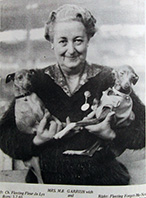
was elected Secretary (the 3rd) and she, together with Mrs Barnard as Chairman, were the organisers of the event.
Mrs Barnard was a breeder of Bulldogs and also become President of the Club.
Mrs Garrish was a breeder of show rabbits at one time and also had a very successful kennel of Whippets. She began her interest in Italian greyhounds in 1956, the same year that Mrs Reiley’s Ch. Golden Arrow of Velletri, bred by Mrs Massey-Cooke and Mrs Cynthia Howard was Best of Breed at Crufts. Photo below.
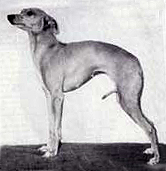
Mrs Garrish had already been invited to take some Whippet pups along to a television studio, where a Crufts related programme was being produced, and she instantly fell in love with the small hounds.
A blue and white trimmed bitch named Fleeting Chichele Atalants began the long list of Champions here in the UK and overseas for the Fleeting (and Fleewards and Seawards – Miss Doreen Buck) affixes.
Mrs Garrish was made an Honorary Life Member of the Kennel Club – only the third lady to be honoured in this manner since women were admitted to full membership. She had been a member of the lady’s branch for some 33 years prior and served on a number of KC committees and judged Best in Show at Crufts in 1984.
The first club open show mentioned above was judged by the recently deceased Miss Elinor Powell (Bryad).
Club Championship status came in 1964 and Mrs Winnie Barber officiated. These were heady days, stock was imported from America, Italy and Germany and many IGs were sent overseas. Registrations peaked at 198 in 1961.
The Berinshill kennel (Mrs Diana Waugh) was extremely influential.
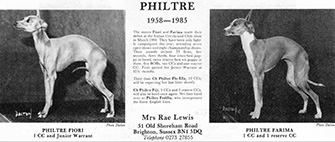
The Philtre kennel owned by Mrs Rae Lewis also began its successful lines. Estrada owned by Barbara and John Scholes was formed, and Mrs Anna Leigh now Marshall, started her Tamoretta kennel. The breed record holder was Ch. Fleeting Flavius, photo.
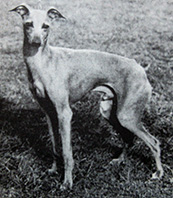
After the upsurge in interest in the breed in the sixties, a number of respected kennels appeared during the seventies.
A glance through the centenary book shows just how much these new owner/breeder exhibitors depended upon the work of those that had gone before. A breed stall selling memorabilia and useful items for Italian Greyhound owners was organised in 1978 firstly at Crufts dog show and then regularly at club functions.
A Rescue organisation was instigated by Mrs Julia Smith and her husband Dr David Smith in 1974 and continued until the Club took over when they retired in 1997.
A separate Rescue Charity was then set up and is now headed by Mrs Helen Rishworth.
The Club News Bulletin took over from the lapsed Club magazine formerly edited by Mrs Cynthia Howard, (Ashgreen), and continues to inform and amuse club members. It is now created by Dr Jill Mellis.
A third show was introduced initially to give future judges another opportunity to go over a number of exhibits before being promoted to Championship judge status.
Education was not overlooked and in the present time is a requirement also of the Kennel Club, to encourage judges to understand the breeds that they undertake to adjudicate.
Health schemes for many breeds are in situ and the Italian Greyhound Club has submitted its own research to ensure participation in the Kennel Club data base, organised by Miss Helen Lister.
Garden parties, now called “Fun Days”, are all part and parcel of the club’s commitment to Italian Greyhound owners.
The Italian Greyhound Club was formed from love of the breed, but it is always important to remember the very giving social aspect for the owners.
![]()
The breed is represented each year at “Discover Dogs” in the EXCEL Centre in London each November
and at Crufts each March. Many of the volunteers are not exhibitors but are just there to tell what they know about the breed and what the dogs are like to live with.
![]()
The 21st century has of course brought forward electronic mail, and communication via individuals here and overseas and is now part of everyday life.
Imports and exports are also part of the modern day picture of exhibiting and ownership. Exhibitors can if they wish, exhibit in other countries and overseas exhibitors have increasingly shown their dogs here in the UK.
There are many hard working people involved in the running of the Italian Greyhound Club, each with their part to play.
It is however the membership who dictate the overall direction and it is hoped that this breed club, now celebrating its 121st year, will continue forward with each and every one of us who loves this beautiful breed contributing in some way.
A toast then to the Italian Greyhound Club!
